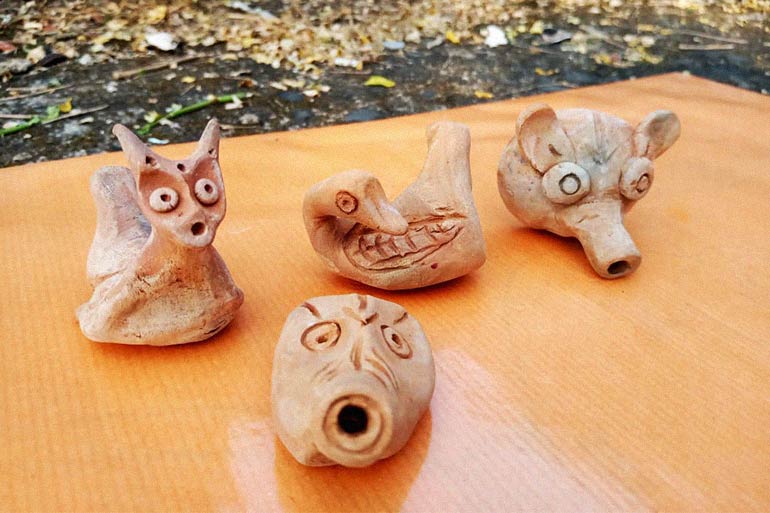Bengal’s flute dolls - blend of folk art & technology – GetBengal story

Doll-making in Bengal is an age-old tradition that reflects exquisite creativity, dedication, and love for the art. Archaeological excavations in different parts of Bengal provide evidence of the ancient craft of doll-making. These dolls have been popular children's toys for centuries. Even being used in religious practices. Dolls from different areas have a distinct local identity. Their role in society and the stories that surround them make them cultural indicators.

Terracotta dolls are still trendy in rural fairs, and their demand shoots up during festivals like Durga Puja, Kali Puja, Charak, etc. In these fairs, you might come across terracotta models of domestic animals like horses, cows, and goats and wild animals like elephants, tigers, deer, and birds, which are still very popular with children. Closer inspection of these puppets reveals the minute details of these unconventional dolls. But they also have an inherent fun element. These dolls have flutes inside them. Every time you hold one such puppet close to your lips and breathe out towards the edge of the hole on the opposite side of the embouchure hole, a melody emanates from the puppet. This ancient indigenous terracotta doll-making craft dates back to 5000 years. The excavated toys and dolls in Harappa and Mohenjo-Daro are examples of our rich ancient heritage.
Rajkumar Debnath, a resident of Baksara in Howrah Santragachi, has given a new lease of life to this ancient craft of making flute puppets (Banshir putul). He is probably the only living artist in Bengal today who makes these dolls. Initially, he started dabbling with flute dolls as a hobby, but in the early 1990s, he made these unique dolls and launched them in the market professionally. A few years later, he took a long hiatus and stopped making dolls altogether. During the 2020 corona-virus lockdown, he took to puppet-making once again.

Debnath’s ancestors hailed from Dhaka, Bangladesh (former East Bengal). When he was young, he watched a woman in the neighbourhood make these flute puppets. She did not sell them but bestowed them upon neighbourhood children to play with. Debnath learnt the techniques of making these dolls from her as a kid, and he continues to make them today. During the conversation, he reminisces, “Kakima (auntie) used to make only horses, but I added more variety and introduced about 10 to 12 types of flute puppets, including horses, elephants, tigers, deer, the profile of Lord Ganesha, birds, et al.”
Puppet dolls are an ideal example of the perfect amalgamation of folk art and technology. Explaining the process of making these dolls, Debnath says, “This doll is best sculpted with Gangamati (clay soil), also known as earthenware or pottery clay. The clay is very sticky, which makes it versatile enough to create ‘banshi putul’. The soil is kneaded to separate the gravel and make a smooth dough, then the dolls are given shapes, and finally, the sculpted dolls are kiln-fired. This is how simple puppets are made in rural Bengal. Now the tricky part of the flute doll making is creating the holes within the puppet for the air to flow after blowing from one end and creating the sound while passing through the hole at the base. This technical aspect is vital and needs to be checked just after sculpting the doll when it is still wet because alterations can be made only at this stage. After inspection, it is kiln-fired at hot temperatures for drying. Sometimes a puppet is sculpted with three or four holes instead of the usual two for a more melodious effect, and one requires pressing the two holes to create music. The melody created thus is just pure magic,” he says.

Debnath does not use mould to make his puppets. He handcrafts each figure with the utmost care and love. Using a branch or twig of bamboo, he makes the holes in the dolls soon after creating them. He paints and draws colourful patterns on the dolls after drying. There is a wide range of puppets, and they are priced according to their sizes. The price of a small flute doll is approximately Rs 100, and as the size increases, so does the price. The largest size he makes comes with a price tag of Rs 1,000 only, and that’s the most expensive puppet he sells. He sells his wares at festivals and fairs, but some connoisseurs collect dolls from his house. If he gets orders in bulk quantities, he delivers them in Kolkata. Besides, he has tied up with courier companies, and he sends his handmade flute dolls to Mumbai, Bengaluru, and other metropolises in the country.
Debnath says his dolls are in great demand at fairs and festivals. “Children are very attracted to this doll. Sales also depend on the location of the fair. Many people buy these dolls as showpieces. I also make decorative pendants with flute dolls. Girls can wear it around the neck and blow the flute to create a melody. A schoolteacher who bought one such pendant shared a funny anecdote with me. One day while she was teaching in a class, the children were causing a ruckus. Instead of yelling at them, she took the pendant to her lips and blew the flute. Children immediately settled down in their seats, and peace was restored. Others regale us with their funny experiences with the flute doll.”

Debnath is a deft craftsman constantly on the lookout for newer media to express his artistic and creative urges. Apart from flute dolls, he used to make terracotta ornaments, intricate, decorative buttons, etc. in the past. He is an art lover and has a personal collection of a variety of dolls in his house. An alumnus of the Industrial Training Institute (ITI) in painting, he was a prolific painter at one time in the past. An alumnus of the Industrial Training Institute (ITI) in painting, he was a prolific painter at one Bankura, and he passed. He continues to make flute puppets due to his unwavering love for art. Craftsmen from Birbhum, Bankura, and Santiniketan invite him regularly to master the technique of making flute puppets. Debnath participates in various organisations and introduces his long-forgotten flute puppets to Mission, etc.; annual invitations from reputed organisations Calcutta Press Club and Golpark Ramakrishna Mission, etc.; and he obliges happily. Scholars researching indigenous puppets frequent his house to talk to him and gather information from him on this craft of Bengal.
Bengal has a rich history of doll-making. The materials used to make the dolls are diverse. Soshthi dolls, Babu dolls, Jhulan dolls, Tushu dolls, Daroga dolls, Radha Krishna, Durga, Shiva, and other deities. The list is endless. Among these clay dolls, the terracotta flute dolls have risen far above the ordinary to become part of the domain of historical documents on folk culture. Rajkumar Debnath is taking steps to ensure this niche doll-making survives for future generations.










